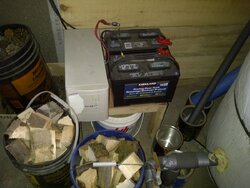M
mikefrommaine
Guest
I have a spring check on the main piping, not on the overheat loop. I use a taco sentry NO zone valve which does not allow any ghost flow in my no power overheat loop as it is closed during normal operation.
As far as flowing through the pump i dont think it will be a problem. Not sure though if it has an internal flow check. I have two indirect water heaters piped in series, with a circulator loop between the two. I had planned to have the pump come on when my wood boiler is at temp and off if I was burning only oil. I found that with the pump off that the two tanks maintained equal temps due to thermosiphoning between the two tanks (through the pump) as well as if the pump was on.
As far as flowing through the pump i dont think it will be a problem. Not sure though if it has an internal flow check. I have two indirect water heaters piped in series, with a circulator loop between the two. I had planned to have the pump come on when my wood boiler is at temp and off if I was burning only oil. I found that with the pump off that the two tanks maintained equal temps due to thermosiphoning between the two tanks (through the pump) as well as if the pump was on.




 I don't see why this setup wouldn't work, I'm still going to run it past an electrician friend to make sure!
I don't see why this setup wouldn't work, I'm still going to run it past an electrician friend to make sure!